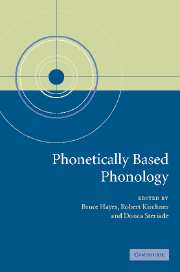Book contents
- Frontmatter
- Contents
- List of contributors
- List of abbreviations
- 1 Introduction: the phonetic bases of phonological Markedness
- 2 A review of perceptual cues and cue robustness
- 3 Place assimilation
- 4 The typology of rounding harmony
- 5 The evolution of metathesis
- 6 The role of contrast-specific and language-specific phonetics in contour tone distribution
- 7 Vowel reduction
- 8 Contrast and perceptual distinctiveness
- 9 Syllable weight
- 10 Consonant lenition
- 11 Language processing and segmental OCP effects
- Index
8 - Contrast and perceptual distinctiveness
Published online by Cambridge University Press: 21 October 2009
- Frontmatter
- Contents
- List of contributors
- List of abbreviations
- 1 Introduction: the phonetic bases of phonological Markedness
- 2 A review of perceptual cues and cue robustness
- 3 Place assimilation
- 4 The typology of rounding harmony
- 5 The evolution of metathesis
- 6 The role of contrast-specific and language-specific phonetics in contour tone distribution
- 7 Vowel reduction
- 8 Contrast and perceptual distinctiveness
- 9 Syllable weight
- 10 Consonant lenition
- 11 Language processing and segmental OCP effects
- Index
Summary
Introduction
Most ‘phonetically driven’ or functionalist theories of phonology propose that two of the fundamental forces shaping phonology are the need to minimise effort on the part of the speaker and the need to minimise the likelihood of confusion on the part of the listener. The goal of this chapter is to explore the perceptual side of this story, investigating the general character of the constraints imposed on phonology by the need to minimise confusion.
The need to avoid confusion is hypothesised to derive from the communicative function of language. Successful communication depends on listeners being able to recover what a speaker is saying. Therefore it is important to avoid perceptually confusable realisations of distinct categories; in particular, distinct words should not be perceptually confusable. The phonology of a language regulates the differences that can minimally distinguish words, so one of the desiderata for a phonology is that it should not allow these minimal differences, or contrasts, to be too subtle perceptually. In Optimality-Theoretic terms, this means that there are constraints favouring less confusable contrasts over more confusable contrasts.
There is nothing new about the broad outlines of this theory (cf. Lindblom 1986, 1990; Martinet 1955; Zipf 1949; among others), but it has important implications for the nature of phonology. First, it gives a central role to the auditoryperceptual properties of speech sounds, since distinctiveness of contrasts is dependent on perceptual representation of speech sounds. This runs counter to the articulatory bias in phonological feature theory observed in Chomsky and Halle 1968 and its successors.
- Type
- Chapter
- Information
- Phonetically Based Phonology , pp. 232 - 276Publisher: Cambridge University PressPrint publication year: 2004
- 77
- Cited by

